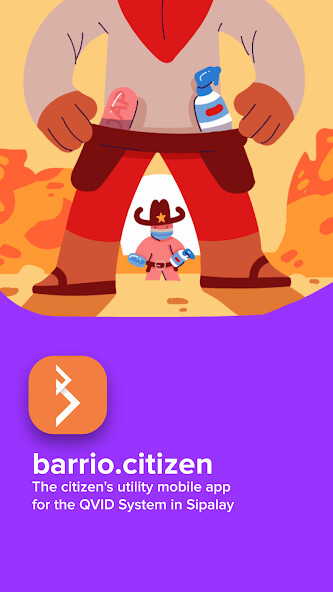We provide barrio.citizen online (apkid: com.arkitek.barrio.residente) in order to run this application in our online Android emulator.
Description:

Run this app named barrio.citizen using MyAndroid.
You can do it using our Android online emulator.
Serving as the resident's profile and identification in the component apps for the QVID Contact Tracing System of the City of Sipalay, Negros Occidental.
The Citizen's QV.ID
An offline-capable, encrypted QR Code enforced with an anti-fake approach.
These codes are mainly utilized with the system's scanning apptsekpointand is the source of a person's travel activity log.
With the system's flagging feature, the QR can be disabled if tagged by the CESU and their BHERTs with flags such as a contact, suspect/probable and wont be able to travel and enter public places/establishments until cleared.
The QR's anti-fake mechanism starts through the proof of residency registrations that are validated by their own barangay councils with a mobile app of their ownbarrio.councilto process their residents submissions.
These codes are encrypted with only the QVID System Apps can read and decrypt it.
Moreover, when scanned, the tsekpoint app would show the Profile Photo of the holder.
If it doesnt match the person's image, it has been tampered.
Uniformity through utility
For citizens without smart phones, one can create a profile under their main account.
They will be then issued a printed QR ID for them to show before entering an establishment.
Currently being used for Sipalay's inclusive communities through creating offline drafts and batch registering.
Transparency on history
As the citizen scans their QR Code prior and exiting an establishment, this records in their travel log.
These records are used in the system's main contact-tracing method of clustering.
One can review the history of where their code had been scanned or whom they've scanned with the P2P feature.
Contact-tracing proper with QVID
The systems contact-tracing procedure is classified in two ways: Clustering and Person-to-Person.
Clustering - Prior on entering an establishment, a gatekeeper will ask a citizen to show their QR Code, scan it and record their entry, which is same as they exit the area.
With this, the people within their time of stay in the area will be extracted as clusters and investigated as contacts.
Person-to-Person (P2P) - Using the app's QR Scan feature, a citizen can scan someone elses QR Code Profile to record a direct contact activity with the person.
This can be applied to visitors with face-to-face transactions or over-the-counter establishments.
Health Declaration Cards
Although optional on busy zones, the City of Sipalay has required to fill-up this form prior to entering an accommodation establishment and other selected businesses.
Once uploaded, the record is valid up until 24 hours.
Curious on how Sipalay implemented QVID?
See for yourself!
https: //www.facebook.com/qvid.ph
The Citizen's QV.ID
An offline-capable, encrypted QR Code enforced with an anti-fake approach.
These codes are mainly utilized with the system's scanning apptsekpointand is the source of a person's travel activity log.
With the system's flagging feature, the QR can be disabled if tagged by the CESU and their BHERTs with flags such as a contact, suspect/probable and wont be able to travel and enter public places/establishments until cleared.
The QR's anti-fake mechanism starts through the proof of residency registrations that are validated by their own barangay councils with a mobile app of their ownbarrio.councilto process their residents submissions.
These codes are encrypted with only the QVID System Apps can read and decrypt it.
Moreover, when scanned, the tsekpoint app would show the Profile Photo of the holder.
If it doesnt match the person's image, it has been tampered.
Uniformity through utility
For citizens without smart phones, one can create a profile under their main account.
They will be then issued a printed QR ID for them to show before entering an establishment.
Currently being used for Sipalay's inclusive communities through creating offline drafts and batch registering.
Transparency on history
As the citizen scans their QR Code prior and exiting an establishment, this records in their travel log.
These records are used in the system's main contact-tracing method of clustering.
One can review the history of where their code had been scanned or whom they've scanned with the P2P feature.
Contact-tracing proper with QVID
The systems contact-tracing procedure is classified in two ways: Clustering and Person-to-Person.
Clustering - Prior on entering an establishment, a gatekeeper will ask a citizen to show their QR Code, scan it and record their entry, which is same as they exit the area.
With this, the people within their time of stay in the area will be extracted as clusters and investigated as contacts.
Person-to-Person (P2P) - Using the app's QR Scan feature, a citizen can scan someone elses QR Code Profile to record a direct contact activity with the person.
This can be applied to visitors with face-to-face transactions or over-the-counter establishments.
Health Declaration Cards
Although optional on busy zones, the City of Sipalay has required to fill-up this form prior to entering an accommodation establishment and other selected businesses.
Once uploaded, the record is valid up until 24 hours.
Curious on how Sipalay implemented QVID?
See for yourself!
https: //www.facebook.com/qvid.ph
MyAndroid is not a downloader online for barrio.citizen. It only allows to test online barrio.citizen with apkid com.arkitek.barrio.residente. MyAndroid provides the official Google Play Store to run barrio.citizen online.
©2025. MyAndroid. All Rights Reserved.
By OffiDocs Group OU – Registry code: 1609791 -VAT number: EE102345621.
